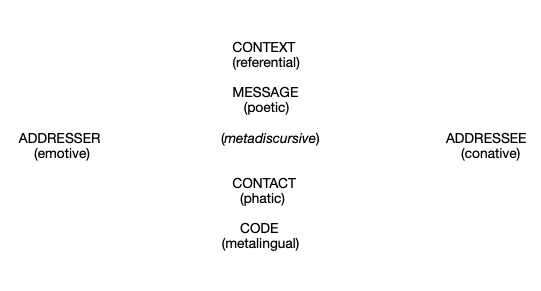I first encountered Jackobson's six
communication functions as an undergrad at Queen's. For me, it offered
a superb way of analyzing multiple approaches to literary objects. I even
wrote a paper on the phatic function in Jacques Godbout's
Salut Galarneau!. The paper was little more than a catalogue of
instances of the phatic function and its distribution over the course of
the novel. It would be a long while longer that I would come to
understand the functions in a dynamic fashion: how the dominance of one
function cedes to the dominance of other functions. And even longer yet to
posit a seventh function ...
Just what are Jakobson's six functions?
Richard Kidder in the "Jakobson" entry in Encyclopedia of Contemporary
Literary Theory: Approaches, Scholars, Terms provides a most succinct
exposition of the six functions: "To each of the six factors that must be
present in order for communication to take place (addresser, addressee,
code, message, contact, context) there corresponds one of six functions
that describe the orientation of the speech act (emotive, conative,
metalingual, poetic, referential and phatic)." I cite Kidder because I
find suggestive the shuffling of factors and functions (the two sets of
enumerations do not correspond respectively [two are switched: phatic -
contact ; referential - context]. One is tempted to observe in this switch
the work of the poetic function whereby the resemblance of the signifiers
"context" and "contact" is exploited. What I underscore here is that in
the very exposition of the factors and functions noise can be at play and
the referential function might be displaced by the poetic.
How the six are represented influences our understanding of their
relations.
The 1960 article where Jakobson sets out the model ("Closing
statements: Linguistics and Poetics") in two layouts (one for factors,
one for functions). Here they are combined in one diagram:

A walk through of the six functions using the example "It is raining"
is offered by Paul Fry's lecture at 32:50.
He notes that "Any function could be the dominant in a certain situation
of any given utterance" and he goes on to read a key passage in Jakobson
as introducing a reliance on intention to distinguish which would be
dominant.
Dominance
The layouts (schema) in Jakobson's article and in most illustrations in
the subsequent literatature display the factors and functions in what leads
to interpretations of equivalency: no one function protrudes in a display
of dominance. Notwithstanding the depiction or schema implying equivalence
among the functions, Jakobson elaborates on dominance relations:
Each of these six factors determines a different function of language.
Although we distinguish six basic aspects of language, we could, however,
hardly find verbal messages that would fulfill only one function. The
diversity lies not in a monopoly of some one of these several functions
but in a different hierarchical order of functions. The verbal structure
of a message depends primarily on the predominant function. But even
though a set (Einstellung) toward the referent, an orientation
toward the CONTEXT -- briefly the so-called REFERENTIAL, "denotative,"
"cognitive" function -- is the leading task of numerous messages, the
accessory participation of the other functions in such messages must be
take into account by the observant linguist.
Roman Jakobson "
Closing
Statement: Linguistics and Poetics" in T. Sebeok, ed.,
Style in
Language, (Cambridge, MA: M.I.T. Press, 1960).
Meta-considerations
Over time the dominance shifts. The question arises as to what the set
might be for focus on the dominance pattern.
Why not widen the notion of "code" and have the metalingual function
determine the dominance pattern i.e. what the next dominant function would
be? The metalingual function arises when addresser and addressee need to
verify that they are using the same code. This is a different function
from tracking the next move in the dominance pattern. In Jakobson’s
description of the metalingual function is like a negotiation between two
parties to construct a product (gloss):
Whenever the addresser and/or the addressee need to check up whether
they use the same code, speech is focused on the CODE: it performs a
METALINGUAL (i.e. glossing) function.
One could stretch the notion of code to encompass shifts in dominance
whether these be rule-bound or the result of chance operations.
However, dominance pattern is not necessarily subject to agreement or
the negotiation implied by Jakobson’s description of the metalingual
function. The set on “code” is associated with a glossing
activity. Maintaining or shifting dominance is an event that belongs
to a different level of abstraction.
A metalingual function points back to an expression or utterance the
occurrence of specific signifiers. There are markers for the the
metalingual function. However the shift in the dominance pattern need
not leave any markers in the signifying chain. It is not as traceable
as a metalingual function. A set on dominance pattern suggests the
existence of a seventh function. I propose it be called the
metadiscursive function.

Acknowledgements
Conversations with Douglas Wayne Robinson sharpened the understanding of
representations of the seventh function when he suggested a point at the
centre of the schema which lead to consideration of the figure from Cusa
of a centre everywhere, circumference nowhere which opened the
consideration that the metadiscursive function belongs to a different
level of abstraction.
The late Peter Nesselroth shared his interest in a fictional seventh
function (Laurent Binet’s novel) and provided a friendly ear in the
early tentative considerations put forth here. His paper on the other
seventh function can be read at
Semiotics_as_Truth_in_Fiction_Laurent_Binets_The_7th_Function_of_Language.
> Created: April 16, 2020
> Updated: February 17, 2021
François
Lachance

